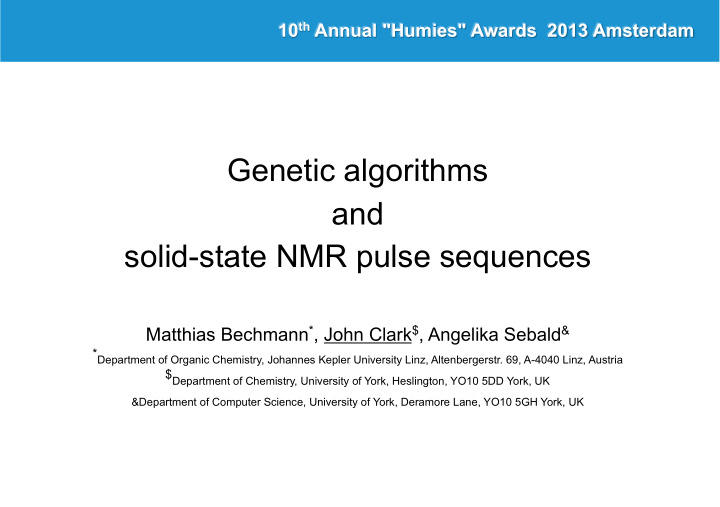



10 th Annual "Humies" Awards 2013 Amsterdam Genetic algorithms and solid-state NMR pulse sequences Matthias Bechmann * , John Clark $ , Angelika Sebald & * Department of Organic Chemistry, Johannes Kepler University Linz, Altenbergerstr. 69, A-4040 Linz, Austria $ Department of Chemistry, University of York, Heslington, YO10 5DD York, UK &Department of Computer Science, University of York, Deramore Lane, YO10 5GH York, UK
NMR: Nuclear magnetic resonance Nuclear magnetic resonance refers to phenomenon where nuclei in a magnetic field can absorb electromagnetic radiation (radio frequency typically) and re-emit it. Happens at specific resonance frequencies the B 0 profiles of which reveal compositional and structural information about molecules under examination for example. Spin interactions encode structural information: distance, electronic environment, ... B 0 2
NMR applications and challenges simple experiment - complex result complex experiment - simple result only distance only distance encoded ● all structural information encoded ● only selective structural information encoded ● information in intensities and shape ● information only in intensity ● complex spin dynamic ● simple effective spin dynamic ● analysis difficult ● analysis easy ● but loss of overall signal intensity Objective : Control spectral information content + high overall intensity 3
Manipulate spin dynamics by rotations ● magic angle sample spinning spatial rotation ● radio frequency pulses rf field spin rotations 4
Genetic algorithms and solid-state NMR ( A ) ... would qualify today as a patentable new invention. Non-rotorsynchronous multipulse experiments have not been tried in solid-state NMR and the specific effects of non-rotorsynchronicity have not been exploited and researched so far. NMR sequences have been patented before. rotor period Perturbation theory only rotor ... ... efficient for synchronous perturbation time search space rf field restricted ... rf period 5
Genetic algorithms and solid-state NMR ( B ) The result is equal to or better than a result that was accepted as a new scientific result at the time when it was published in a peer-reviewed scientific journal. Our new experiments carry traits of formerly published and highly influential experiments (POST-C7 and C7) which were developed using perturbation theory. However, our experiment offers much theoretical optimum improved experimental Experimental efficiency [%] performance. These papers have over 600 citations between them. GA best perturbation theory 6
Genetic algorithms and solid-state NMR [( C ) The result is equal to or better than a result that was placed into a database or archive of results maintained by an internationally recognized panel of scientific experts. There is is no single database. The databases are usually specific to a class of compound and its spin systems like proteins, polymeres, etc. In biomolecular chemistry large databases exist, but these contain mostly data from liquid-state NMR. Solid-state NMR is predominately published in scientific literature but some (short) lists exist: http://www.bmrb.wisc.edu/data_library/solidstate/ http://www.drorlist.com/nmr/SPNMR.html 7
Genetic algorithms and solid-state NMR ( D ) The result is publishable in its own right as a new scientific result independent of the fact that the result was mechanically created. The work is published in a leading NMR journal (Journal of Magnetic Resonance). Our results greatly enhance the operational range of solid-state NMR experiments and provide pointers for the future development of new theoretical methods. The results are of clear interest to the NMR community experimental efficiency theoretical optimum spin system dependent Experimental efficiency [%] distance information GA best dominating perturbation theory electronic influence dominating 8
Genetic algorithms and solid-state NMR ( E ) The result is equal to or better than the most recent human-created solution to a long-standing problem for which there has been a succession of increasingly better human-created solutions. The suppression of chemical shielding anisotropy has not been better in any other experiment under these experimental conditions. We are dealing here with difficult cases. There exist many perturbation theory derived experiments aiming at the same goal as we. E.g. paper by Levitt (table 5 and table 7) gives a selection of experiments doing the same as we want but fail for the same reasons C7/PostC7 does. We improve on their work. Symmetry-Based Pulse Sequences in Magic-Angle Spinning Solid-State NMR . Levitt 2002.
Genetic algorithms and solid-state NMR ( F ) The result is equal to or better than a result that was considered an achievement in its field at the time it was first discovered. The seminal papers POST-C7 [3] and C7 [4] were immensely influential on the development and success of solid-state NMR over the past two decades. These papers are very widely cited in the field. Our work is a significant extension. Efficient diploar recoupling in the NMR of rotating solids. A sevenfold symmetric radiofreqiuency pulse sequence. Lee et al. 1995. 327 cites. Broadband diploiar recoupling in the nuclear magnetic resonance of rotating solids: A compensated C7 pulse sequence. Howey et al. (1998). 277 cites. 10
Genetic algorithms and solid-state NMR ( G ) The result solves a problem of indisputable difficulty in its field. Measuring inter-nuclear distances without chemical shielding interference is a long standing issue in solid-state NMR. Our initial results only partially solve the problem because NMR experiments typically require multiple performance criteria to be met at once; … . however, we can readily extend our research for multi-objective criteria Most likely, the concept of non-synchronicity can be applied to all types of NMR experiments, opening a completely new school of thought how NMR experiments should best be conducted. 11
Why we should get a prize It’s a foray into heavyweight science! Results of interest to a large and crucial scientific community and published in major NMR journal: Motivated by NMR theory and takes NMR into a new space. Performs well against several Humie criteria. And readily extendible to multiple criteria and also to other NMR experiments: excellent potential for further influence on science via a raft of evo-techniques. 12
Recommend
More recommend